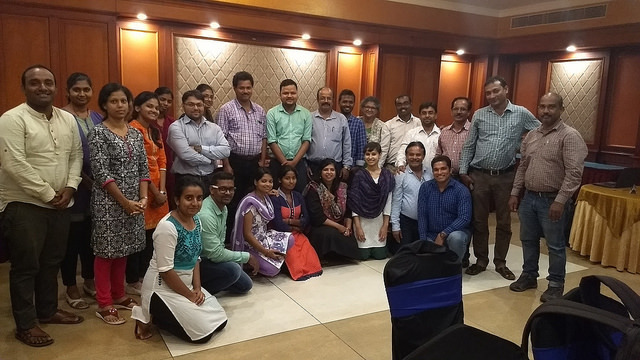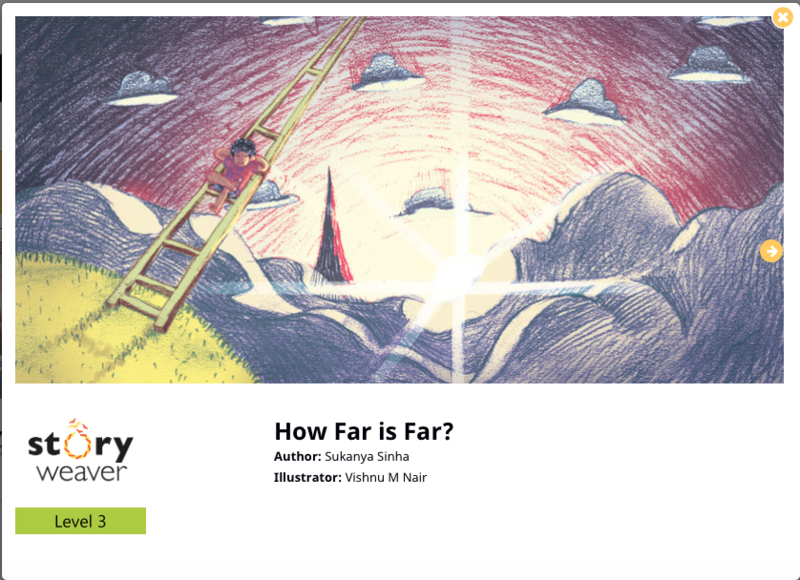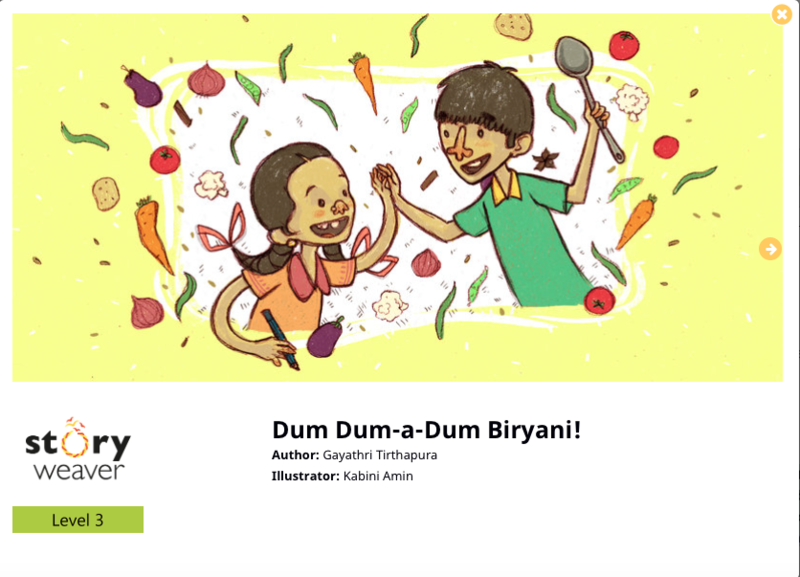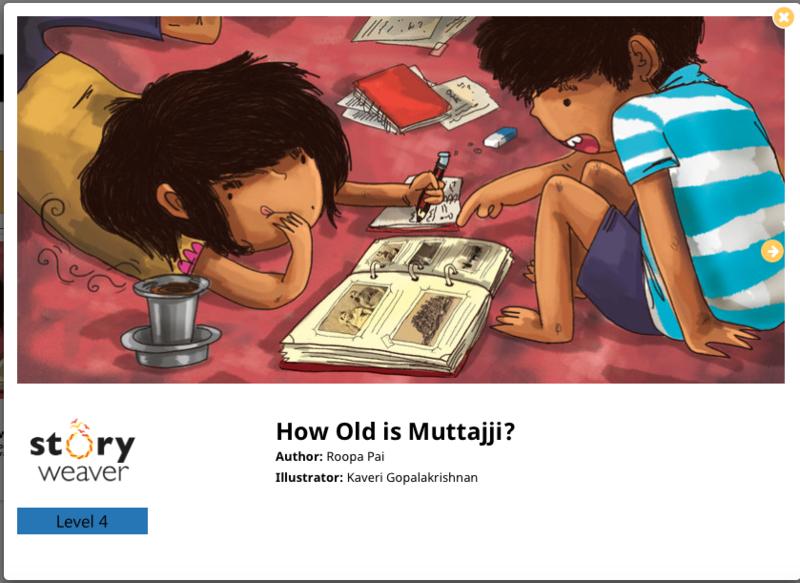Workshop Announcement: Reading with StoryWeaver in Namma Bengaluru
Posted by Remya Padmadas on August 30, 2018StoryWeaver invites educators and resource people from organisations to attend a workshop to be held in Bengaluru on 6th and 11th September in Koramangala. Participants will gain an understanding of how to use StoryWeaver with the children they work with. This includes how to:
-
Browse, read & curate a reading list from over 9000 stories across 118 languages
-
Download stories for offline reading
-
Create a new story or a set of flashcards from an image bank of over 11000 illustrations
- Re-Level / Re-Mix a story to suit your child's needs
- Translate stories to a language of your choice
And best of all, ALL of this is absolutely FREE!
To celebrate language diversity, we are planning to conduct the workshop session in English on the 6th and in Kannada on the 11th. You are requested to give your preference for the date/language while signing up. However, just in case we are not able to attract enough participatio
The workshop would cover the following:-
- A demonstration of StoryWeaver and the platform's key functionalities
- Examples of how educators are using StoryWeaver effectively in their classrooms
- Dedicated work time for participants to try their hands on StoryWeaver
- An opportunity to meet other educators and have interesting conversations

Participants at a recent StoryWeaver workshop.
If this excites you, REGISTER HERE to book your place in the workshop, latest by 3rd September, Monday.
Please note that the seats are limited and we might not be able to accommodate more than 2-3 people per organization. Confirmed participants will get a separate email confirming their participation and other logistical details.
The workshop will be held between 10 a.m to 4.30 p.m and there is no fee to attend the workshop.
Feel free to reach out with any questions to Khyati at [email protected].
comments (3)70 Haryanvi Books created in our first ever Translation Hackathon
Posted by Sherein Bansal on February 21, 2018In the second week of February, a three-member team from Pratham Books visited Rohtak, Haryana to conduct a translation workshop with 25 teachers from 20 districts. Little did we anticipate the warmth and love we would receive from the participants who came from all over Haryana. But what was truly inspiring was that these teachers stayed overnight at the Government Senior Secondary School in preparation for this workshop. They were so self driven that they had explored StoryWeaver and made themselves a little familiar with it even before we entered the school premises.
The main aim of the workshop was to conduct a translation hackathon. This meant working with teachers to translate Pratham Books titles to Haryanvi on our digital platform, StoryWeaver. Every teacher translated at least three Level 1 and Level 2 books. But before that, they all took turns telling us about their favorite childhood stories that have stayed with them effortlessly, emphasizing the huge retentive power of stories.
Their welcome sign for us on the blackboard
It was exciting, the idea of translating children's books to their first language. Most of us won't question the existence of books in the languages that we first spoke at home. Not so much for anyone whose mother language is Haryanvi. The teachers speak it, but are not used to reading Haryanvi in books. Also, it changes its dialect with every district and even within a district. So the challenge was to translate stories in a way that's mostly uniform and can be understood by a child who belongs to any part of the state. The discussions that ensued among the teachers reflected their expertise in the language but also the mutual respect they had for each other's opinions. They reviewed each other's work in pairs and with the final feedback incorporated, every teacher enthusiastically read out their work to the whole class.
The most important appeal for everyone involved here was that in two days, this translation hackathon yielded a proper set of 71 Haryanvi books! More and more children across India, and specifically in Haryana, can now read stories in their own language.
During the workshop, we talked about the value of translation, the concerns behind it, and the importance of translating meaning to meaning instead of word to word, and from one cultural context to another. We talked about StoryWeaver, our open repository of children's books, and the ways they can use this platform in their classrooms for free to enable joy of reading among students. The teachers agreed that the essence of their language lies in its humour, and there was plenty of that for the time we spent with them!
After a delicious meal, we were ready to leave and bid farewell to the fresh air of the town when the teachers insisted that we stay a bit longer. Some teachers performed impromptu plays for us, some sang and others made us laugh.
It was truly a memorable workshop with every teacher an eager champion of Haryanvi in their own school and in their own district. And with that, the number of languages available on StoryWeaver rose to 107. There could have been no better way to ring in the International Mother Language Day.
Browse and read the Haryanvi stories on StoryWeaver.
comments (3)
Finding the Math in Storybooks for Young Children
Posted by Remya Padmadas on April 18, 2016It's important to share engaing books with children that have math learning as a primary goal.
Via MindShift.
When reading books, it’s important to realize that math is a broad subject. Clearly, a counting book or a shape book describing circles and squares are both explicitly about math, in the sense of the kind of formal math we usually learn in school. Although not explicitly about school math, Goldilocks entails relatively complex math ideas— order and correlation. Other storybooks deal in an informal way with patterns, spatial relations, measurement, addition and subtraction, and division — all of which are “math.” Indeed, it would be hard to find a non-math storybook that does not include everyday math in this broad sense. In fact, ordinary storybooks may contain more interesting math than do explicit math storybooks (and textbooks, too!).
This in turn raises the question of the type of math you want your child to learn — school math or embedded math? The answer is both. Children need to memorize the counting words, but also need to know that their order specifies relative magnitude. They need to memorize 1, 2, 3, 4, but also need to know that 3 is a bigger number than 2 because it comes after 2, but it is also a smaller number than 4, because it comes after 3. Memorizing symbols is not enough, just as knowing the everyday story is not enough. Eventually, the child needs to know how the informal ideas provide the meaningful basis for the formal math.
Read books that you both find interesting, amusing and full of wonder, books that will grow the child’s budding love of reading. Bypass boring stories, even if you think they are “educational.” Enjoy the story!
You can read the rest of the article here.
StoryWeaver recently created a series of openly licensed, digital-first books that celebrated math concepts from the simple to the slightly abstract. Created under an Oracle Grant, these books were guest edited by renowned children's author Roopa Pai and dealt with every day fractions, Fibonacci series, dates and distances small and great. Roopa wrote one of the stories, 'How Old is Muttaji?' - a delightful concoction of math, history and culture!
The books were part of a larger set of STEM books that were created to fill a gap in children's publishing in India: engaging non-fiction books and joyful, non-fiction narratives.
How Far is Far by Sukanya Sinha and Vishnu M Nair

If you thought your friend's house on the other side of town was far away, you have clearly not read this book. Climb the Magic Math Ladder to get from where you are to the top of Mount Everest, to Kashmir, to the moon, the Sun, and ultimately, to the edge of the Universe, which is very, very, VERY far away indeed. Ready, steady, go!
Dum Dum-a-Dum Biryani by Gayathri Tirthapura and Kabini Amin

Basha and Sainabi are in a panic. Ammi is ill, and Saira aunty has just announced that she is arriving for lunch - with 23 other people! Budding chef Basha thinks he can cook Ammi's Dum Biryani, but her recipe only makes enough for 4 people. Math wiz Sainabi jumps in to help, declaring that she knows how to turn a 4-person recipe to a 24-person recipe. Do the siblings succeed in serving up a truly Dum Dum-a-Dum biryani? Read this book to find out!
The Fascinating Fibonaccis - by Shonali Chinniah and Hari Kumar Nair

Almost a thousand years ago, an Indian scholar called Hemachandra discovered a fascinating number sequence. A century later, the same sequence caught the attention of Italian mathematician Fibonacci, who wrote about it. The Fibonacci sequence, as it began to be called, was straightforward enough - what made it fascinating was that this particular set of numbers was repeated many, many times in nature - in flowers, seashells, eggs, seeds, stars... Find out more inside this book!
How Old Is Muttaji? by Roopa Pai and Kaveri Gopalakrishnan

Putta and Putti know that Muttajji is really, really old. But exactly HOW old is she? Join the twin detectives on an exciting mathematical journey through Muttajji's memories and India's history in their quest to crack the big question.
Have a look at these digital books, which are all available to read, download and print for sharing absolutely free! The books are also available in a number of Indic languages, and if you'd like to translate the book in to a language you're fluent in, you can use our translate tool!
Be the first to comment.